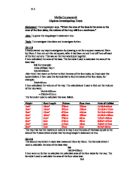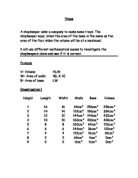It's easier to see the radius of the enclosing sphere if we place the tetrahedron inside a cube:
Figure 3
The 4 vertices of the tetrahedron are H,F,C,A.
The 4 faces of the tetrahedron in this picture are: CFH,CFA,HFA, and at the back, HCA.
The vertex D is a part of the cube, not the tetra.
The vertices of the cube all touch the surface of the sphere. The radius of the sphere is the diagonal of the cube FD.
In this analysis and the ones following, we will assume that all of our polyhedra are enclosed within a sphere of radius = 1. That way we will be able to accurately assess the relationship between all of the 5 regular solids.
The radius of this sphere is OF = OD = 1. How does the side of the tetrahedron relate to the radius of the sphere?
The side of the tetrahedron is the diagonal of the cube (e.g., AC, HC, HA above are 3 of the 6 sides of the tetrahedron).
Figure 4
So FC is the side of the tetrahedron, DC is the side of the cube, FD is the diagonal of the cube and the diameter of the sphere enclosing the cube. By Pythagorean Theorem, FC = \/¯2 * FG and also FD² = FC² + DC² . Assuming (temporarily) the side of the cube DC is 1, then FC = \/¯2 and
FD = \/¯(1 + 2) = \/¯3.
So FG(side of cube), FC(side of tetrahedron) , and FD(diameter of enclosing sphere) have a 1, \/¯2, \/¯3 relationship.
We know OF = 1, so FD = 2. We also know FC / FD = \/¯2 / \/¯3, or
FC = (\/¯2 / \/¯3 ) * diameter of enclosing sphere. The radius OF is 1/2 the diameter FD.
So FC = (\/¯2 / \/¯3) * 1/2 radius
FC = [(2\/¯2) / \/¯3] * radius.
Now we have the side of the tetrahedron in terms of the radius of the enclosing sphere.
So we write s = [(2\/¯2) / \/¯3] r, or, s = 1.632993162r.
s is also called the chord length.
What about the centroid of the tetrahedron?
The centroid is at O in Figure 3. The distance OF is the distance from O to any of the 4 vertices of the tetrahedron, which we have already seen is the radius (r) of the enclosing sphere = 1.
In terms of the side of the tetrahedron, the distance OF = r = 1 / 1.632993162s = 0.612372436s.
I don't like repeating decimals because they don't say anything geometrically.
I prefer to write r = [\/¯3 / (2\/¯2)]s.
What is the central angle of the tetrahedron? In Figure 3, the central angle would be AOC or maybe AOH. The central angle is the angle from one vertex, throught the centroid O, to another vertex.
Here we have to use trig.
vertex vertex
centroid
Figure 5
We figure everything in terms of the side of the tetrahedron.
OF = OH = radius of enclosing sphere. FH = tetra side = s.
IF = 1/2 * FH = 1/2 * s.
So sin(<IOF) = IF / OF = 1/2 / [\/¯3/(2\/¯2) ] = [(2\/¯2) / (2\/¯3)] = \/¯2 / \/¯3.
<IOF = arcsin(\/¯2 / \/¯3) = 54.73561032°. The central angle FOH = 2 * <IOF.
Central angle = 109.4712206°
What is the surface angle of the tetrahedron? The surface angle is that angle made by the angles within the faces. Since each face of the tetrahedron is an equilateral triangle, the surface angle = 60°
What is the dihedral angle of the tetrahedron?
The dihedral angle is the angle formed by the intersection of 2 planes:
Figure 6
Let's say BAC and BDC are 2 intersecting faces of the tetrahedron. E is at the midpoint of BC.
AE and DE are lines that go through the middle of each face and hit E.
The dihedral angle is <AED.
The triangle EPD is right. <PED = 1/2 <AED by construction.
AD is the side of the tetrahedron s, so PD is ½ * s
We know, from , that ED = (\/¯3/2)s
sin(<PED) = PD/ED = 1/2 / \/¯3/2 = 1/2 * 2/\/¯3 = 1/\/¯3.
<PED = arcsin (1/\/¯3) = 35.26438968° <AED = 2 * <PED,
Dihedral angle = 70.52877936°
What is the distance between the centroid and the middle of one of the faces (OJ)?
What is the distance between the centroid and the midpoint of one of the sides (OI)?
What is the distance between the centroid and any vertex (OH)?
These distances will be important when we look at the Synergetics concepts of Buckminster Fuller.
Figure 7 -- showing the tetrahedron in cube.
In Figure 7, OF = distance from centroid to a vertex, in this case, F,
OJ = distance from centroid to middle of a face, in this case, face ACF,
OI = distance from centroid to middle of a side, in this case, the side FH.
The 4 faces are CFH, CFA,HFA, HCA as before. The centroid is at O. The middle of face CFA is J. The midpoint of the side of the tetra FH is at I.
We have already figured out OF = OC = OA = OH, the distance from the centroid to any vertex. This is, as you recall, [\/¯3 / (2\/¯2)]s
Let's get OI first. Go back to Figure 5. The distance OI on that figure is the same as the distance OI in Figure 7.
OI² = OF² - IF² = [\/¯3 / (2\/¯2)]² - 1/4 = 3/8 - 1/4 = 1/8.
So OI = [1 / (2\/¯2)]s.
It turns out that the triangle FJO in Figure 7 is right. This will enable us to get the distance OJ.
We already know OF = [\/¯3 / (2\/¯2)]s.
From we know FJ = 1 / \/¯3.
So OJ² = OF² - FJ² = [\/¯3 / (2\/¯2)]² - (1 / \/¯3)² = 3/8 - 1/3 = 9/24 - 8/24 = 1/24.
OJ = 1/\/¯24 = 1 / (2\/¯6).
OJ = [1 / (2\/¯6)]s.
To get a good idea of relative distances, re write OF as [3 / (2\/¯6)]s and OI as [\/¯3 / (2\/¯6)]s
So the relationship between OJ, OI and OF is 1, \/¯3, 3.
Special characters:
\/¯ ° ¹ ² ³ × ½ ¼ Ø \/¯(ز + 1)







